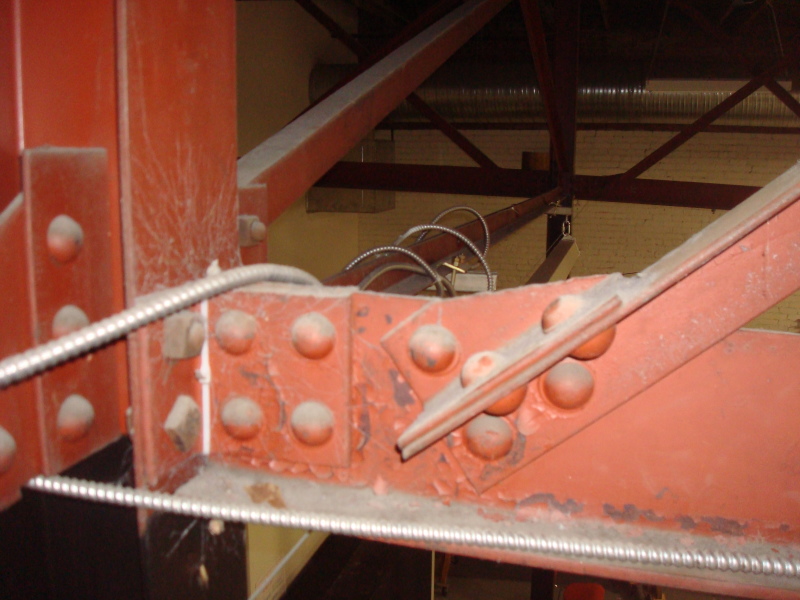Guastavino
Structural
- Jan 29, 2014
- 381
Interesting Fun problem here. So I have a what I think is a double warren truss (ISH). It spans about 50' and you are seeing the mid-span in the picture. So they are single angles that are riveted at the midpoint.
It appears as though the original designer assumed that the rivet point at the center was a brace point. Frankly, I don't disagree because the opposite side angle is in tension when one is in compression (Generally speaking).
So It also appears that the original designer did not assume eccentricity for single angle compression, because well, he likely didn't have a computer back in 1940. SO, with that said, I'm tasked to determine load capacity of the roof. Frankly, I don't have too many issues with assuming concentric load and a brace point at the center. Each angle has double rivets on the end, so it's more or less "fixed" to the WT top and bottom chords. Also, that RIVET at the center really does stiffen the whole thing up a lot, because in order to buckle, it would have to buckle a high tensioned angle. I don't see that happening.
I'm not trying to get ridiculous load capacity out of the truss. It should have been designed for 30 psf per the 1936 building code. I only want 20 psf of live that I can then reduce to the local snow load to tell them they can hang say 5-8 psf. The roof wood members are rated for right about 30 psf. So I'm thinking that the truss was "designed" for around 20-30 psf of live load. If I use eccentric loading the truss wont work. So what I'm really asking is, am I stepping too far out on a limb here?
It appears as though the original designer assumed that the rivet point at the center was a brace point. Frankly, I don't disagree because the opposite side angle is in tension when one is in compression (Generally speaking).
So It also appears that the original designer did not assume eccentricity for single angle compression, because well, he likely didn't have a computer back in 1940. SO, with that said, I'm tasked to determine load capacity of the roof. Frankly, I don't have too many issues with assuming concentric load and a brace point at the center. Each angle has double rivets on the end, so it's more or less "fixed" to the WT top and bottom chords. Also, that RIVET at the center really does stiffen the whole thing up a lot, because in order to buckle, it would have to buckle a high tensioned angle. I don't see that happening.
I'm not trying to get ridiculous load capacity out of the truss. It should have been designed for 30 psf per the 1936 building code. I only want 20 psf of live that I can then reduce to the local snow load to tell them they can hang say 5-8 psf. The roof wood members are rated for right about 30 psf. So I'm thinking that the truss was "designed" for around 20-30 psf of live load. If I use eccentric loading the truss wont work. So what I'm really asking is, am I stepping too far out on a limb here?

